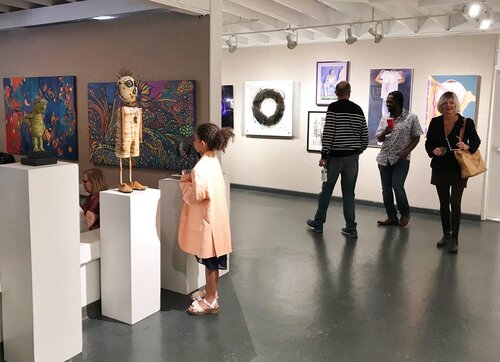by Carolyn Edlund
A working knowledge of your collector and their motivations will help you market your art more effectively.

Do you have a clear idea of the right customer for your work? If not, it’s impossible to develop a plan to effectively reach potential collectors. Hoping to sell to anyone who strolls by, or advertising to everyone in general, is a scattershot method based on wishful thinking. It wastes time, energy and money, and can sink your whole business.
Conversely, coming to know your customer as completely as possible gives you the knowledge and focus to approach the correct market. It allows you to create branding and messaging that connects with them emotionally, and encourages further communication.
As you continue to cultivate your ideal audience, you have opportunities for repeat and referral sales. This happens more easily because you aren’t spending your efforts on trying to sell to people who will never buy from you anyway.
How many people actually buy original art and fine craft? Not many. Only a small percentage of the public has the desire and budget to do so. Most people shop at major retailers, such as department or furniture stores or big brand sites to buy accessories and wall decor for their home or office. That’s perfectly fine; they simply aren’t your customer. But you don’t need most people as prospective collectors. Instead, narrow your marketing efforts to a specific group of people you identify as being the best potential customers. That is called targeted marketing.
It’s very possible to earn a good living from a small percentage of the population who loves and supports the arts in general and your art specifically. You just need to know who your customer is and where to find them.
Understand your customer
There are several ways to gain a clear understanding of your customer. As you present your work in person, through shows, exhibitions, studio sales, art walks and other events, identify the people who respond. Speak with them. Ask questions, and listen carefully. And going forward, as you discuss your work with others, pay attention to feedback, comments and requests. Do this for the purpose of knowing who they are, what their lives are like, and what they value.
These activities will help you draw a profile of your ideal customer. Identify their age, gender, marital status and profession. Where do they live? Are they urban, suburban or rural? What reasons do they give for their interest in your work? Where would they place it? How does it reflect their personal values and needs? Over time, you will be able to develop a profile that identifies certain characteristics of good prospects, so that you can create messaging that connects with them.
Having a customer profile in mind when you create in the studio allows you to deliberately design with them in mind. Your customer profile may cause you to choose certain materials, colors, sizes, or themes, and use price points geared towards their pocketbooks.
If your work fits well into a niche market, it’s easy to identify people who have a great interest or investment in that niche. Where do they gather? What organizations do they belong to? Which magazines or blogs do they read? What other items do they buy? Who do they respect as authorities in that niche? The more you are involved in the world of your collectors, the better you can stay up to date, and also become known.
When you choose your customer and plan to enter the marketplace that they frequent, sales can increase dramatically. Purposefully designing your work for a particular market segment gives you more control over the focus of your marketing and sales. And, you can use feedback from those customers to make items that are an even more perfect fit for them, thereby increasing repeat sales.
What motivates them?
People who seek out original art and handmade work are a special breed. They appreciate the talent and experience of the maker. They consider themselves selective because they are searching for objects that aren’t mass-produced, common or even readily available. Instead, they seek out creative work that is unique and different.
The desire to buy art says a lot about this customer. It reflects on their self-perception and what they want others to believe about them. When they purchase a piece of art as a gift, it sends a very special message to the recipient about the giver’s taste and generosity.
By addressing your purchaser as a “collector” you honor them, and elevate them. It’s a heady thing to be an art collector!
Typically, customers who purchase original art and handmade work are well-educated, highly creative and talented themselves. But instead of expressing their creativity by making art, they do so by owning and collecting it. These are people who value the aesthetic, the authenticity, the concept, and the work ethic of artists. They also often admire the lifestyle of artists, and their perceived “freedom” from a conventional path.
Purchasing original art or handmade work allows the collector to own a piece of your creativity and your artistic soul. They will often speak to others who viewed their acquisition, telling them your story and sharing your inspiration. This can be an important part of the buying experience. As you share your story and build relationships with your prospects, you will become more important to them.
Collectors crave the experience of knowing you, and owning, displaying or wearing their newest acquisition. It brings them joy and the pride of ownership. As you engage with your customers, remember this. Make their experience as pleasurable as possible by being fully engaged, sharing your story and your inspiration, and offering thoughtful customer service.



Speak Your Mind